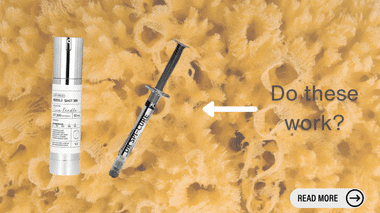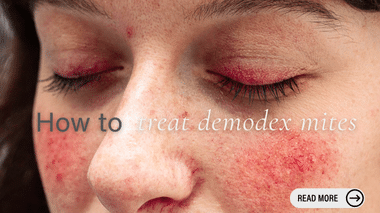
Guide to demodex mites on your face: Treatment options & lifestyle tips


Most of us have demodex mites on our face – Research suggests that around 80–90% of adults carry them.
The real question is “Are these mites actually causing problems for my skin, or even my scalp?” Let’s answer that.
Demodex mites are microscopic, eight-legged creatures that live in our hair follicles and oil glands, especially on the face and scalp, feeding on sebum and dead skin cells.
There are two species in humans:
By day, Demodex mites hide inside follicles, and by night, these nocturnal microscopic arachnids crawl out to mate. This is why many patients experience itching, crawling sensations, or flare-ups of discomfort in the evenings or overnight – when mite activity is at its peak.
We know it may all feel hair-crawlingly disgusting, but these mites are natural. Problems only arise when their numbers multiply, causing conditions like rosacea.
Unlike acne, which produces a mix of blackheads, cysts, and larger spots, Demodex usually causes clusters of small, uniform bumps or pustules centred around hair follicles. These bumps often resist standard acne treatments.
Rosacea, a condition known to be associated with higher Demodex populations, can also look similar with redness and flushing. The biggest key difference is with demodex-related rosacea, skin often feels rough like sandpaper with symptoms worsening at night.
Eyelid involvement is particularly distinctive: lashline crusting, cylindrical dandruff at the lash base, itching, lash shedding, or a crawling sensation are classic signs of mite colonisation.
On the scalp, demodex mites can be mistaken for chronic dandruff or seborrhoeic dermatitis. Persistent itching or burning, flaking with a greasy sheen, and folliculitis-like bumps at follicle openings suggest Demodex involvement.
When inflammation persists, it may even contribute to hair shedding or thinning.
Demodex are typically harmless tenants, but certain conditions create the perfect environment for them to thrive:
It’s essential to emphasise that overgrowth has nothing to do with poor hygiene. You can wash your face twice a day and still have a demodex mite overgrowth.
Demodex are part of our natural skin microbiome. We acquire them early in life, most likely through close contact with family, and they coexist with us, usually quietly and without issue. In balanced numbers, these mites even play a role in recycling excess oil and dead skin cells.
And yes, other animals have them too: dogs carry Demodex canis, cats and cattle have their own Demodex species. In each case, mites are normal inhabitants, but overgrowth causes skin irritation and disease.
So, having them is not unusual – it’s a natural part of biology. The real issue is whether their numbers are tipping the balance on your face or scalp.
Many patients arrive convinced they have acne, but the pattern of bumps, redness, or eyelid irritation sometimes suggests something different.
During your consultation, we begin with a careful visual assessment – years of experience enable us to recognise Demodex-driven inflammation at a glance.
The pattern is usually distinctive:
Where needed, we may take things a step further:
Patients often find it reassuring to see the process in action: you’ll understand not just what is happening to your skin, but why. From there, we can develop a personalised treatment plan with you – whether that involves topical therapy, in-clinic protocols, or scalp-directed care.
For Demodex overgrowth on the face, treatment often starts with topical therapies.
We might prescribe a clarifying lotion containing ingredients such as tea tree oil to reduce mite populations and calm inflammation on the surface, thereby restoring balance in the follicles and lowering mite density while improving texture and reducing redness.
Now, because Demodex is closely linked with rosacea, energy-based treatments are also effective. At SL Aesthetic Clinic, we use the long-pulsed Nd:YAG laser to target inflamed follicles directly. Performed regularly, rosacea laser therapy helps regulate mite activity, control sebum production, and reduce inflammation within follicular units.
As an added benefit, it diminishes the appearance of visible blood vessels (a common rosacea symptom), helping the skin feel and appear clearer and calmer.
To maintain results over time, we often prescribe maintenance therapy. Rosacea Cream*, applied once daily, can help keep mite populations under control between laser sessions. The combination of cream and regular laser therapy provides long-term stability, preventing flare-ups and maintaining skin comfort.
*Please note: Rosacea Cream is currently unavailable in Malaysia, Thailand, and Indonesia, and should only be purchased from authorised clinics in Singapore to ensure authenticity.
On the scalp, management is more complex because hair density makes topical therapy alone less effective.
At TrichoLab, treatment starts with a scalp imaging and analysis session, which allows us to visualise mite density, follicular inflammation, and scaling. Based on these findings, a multi-step protocol is prescribed.
A treatment session often begins with a clarifying scalp mask, designed to calm irritation while lifting away the debris that harbours mites. This is followed by a Demodex-specific scalp wash, formulated to target mite activity directly within the follicles.
To further alleviate mite infestations and reduce inflammation, infrared light therapy is employed, which also promotes healing and follicle recovery. Finally, a Scalp Relief Solution is applied to repair the scalp barrier and restore comfort, ensuring a healthier long-term environment.
In cases where scalp demodicosis is more advanced, for example, when there is significant folliculitis or hair shedding, medical and/or lifestyle therapy may be combined with these protocols, providing comprehensive control over mite overgrowth and its effects.
At our clinic, we often recommend that patients undergo oral or topical medical therapy in combination with scalp care for optimal results.
Managing Demodex isn’t just about prescriptions and clinic treatments, but also about how you care for your skin daily.
At home, these small changes can help strengthen your skin’s ability to keep its health and balance.
We understand that patients feel uneasy when they hear that Demodex mites are overgrowing on their skin. These organisms are simply part of being human, and with the correct diagnosis and treatments, both facial and scalp demodicosis can be effectively controlled. Most of our patients look forward to calmer skin and renewed confidence once their irritation, bumps, and itching settle.
Worried about stubborn bumps, redness, or scalp itch that might be linked to Demodex? Visit us for a consultation. Together, we’ll restore balance so your skin and scalp feel calm, comfortable, and clear again.
Like what you read? Share them!